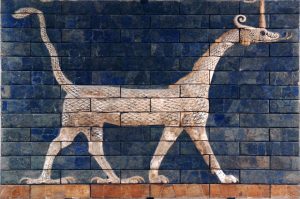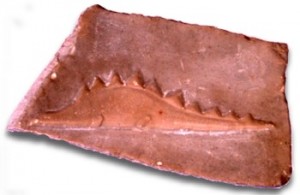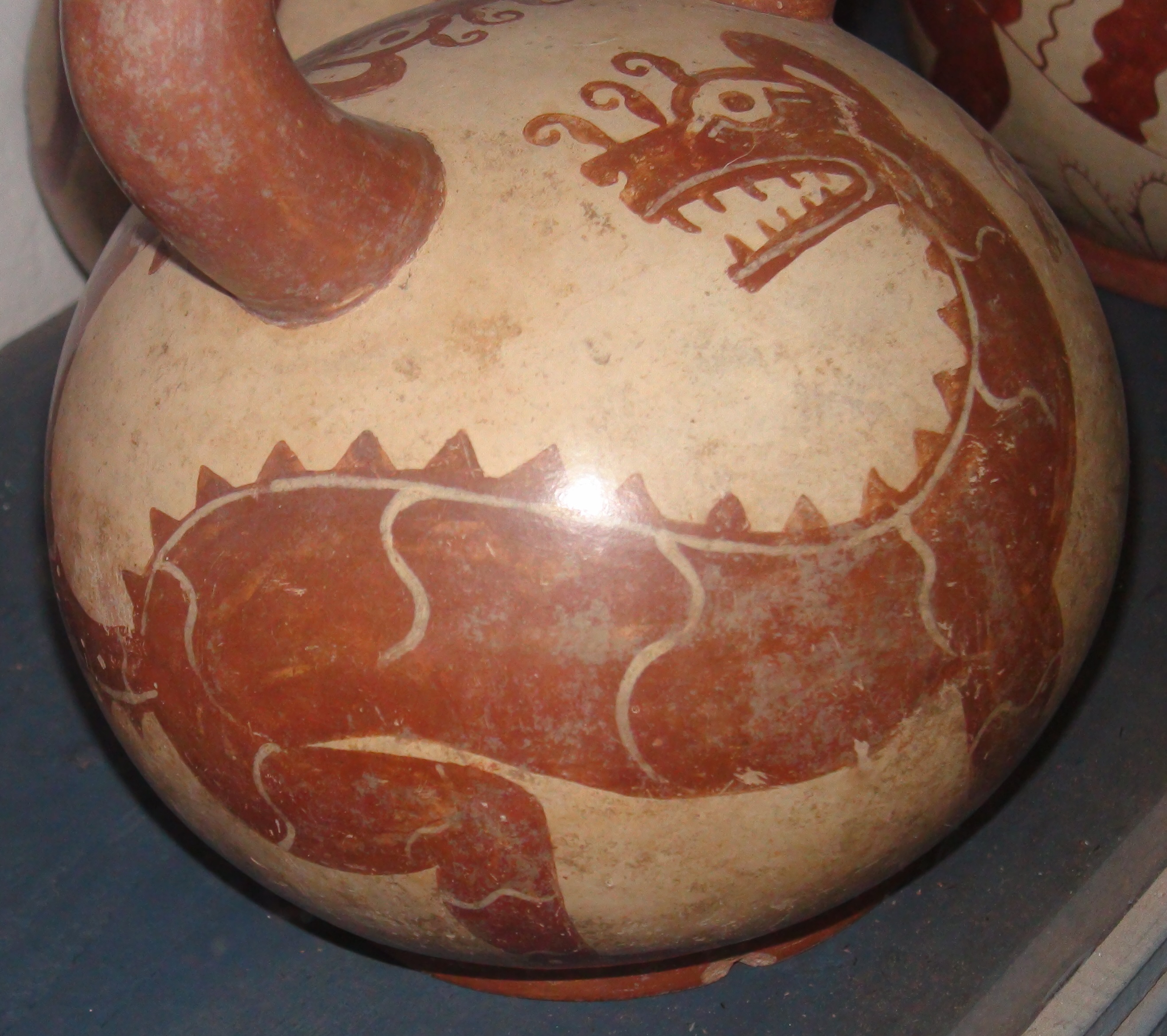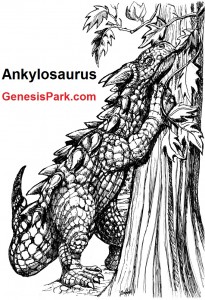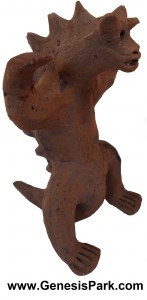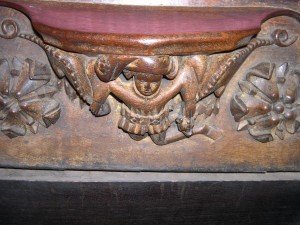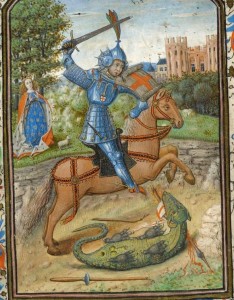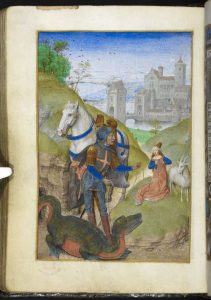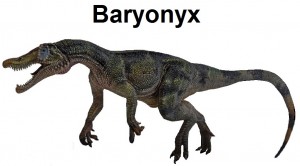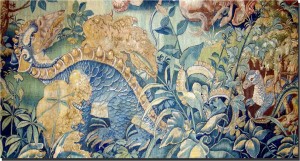Ancient Dinosaur Depictions
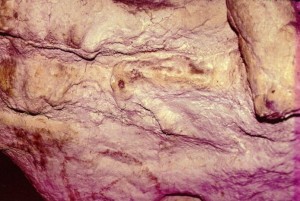
 To the right is a picture of what appears to be a bipedal dinosaur with small arms in head-to-head combat with a mammoth from the book Buried Alive by Dr. Jack Cuozzo (click to enlarge). It was taken by the author in Bernifal Cave, one of the caverns in France that is renowned for Neanderthal art. Mammoth drawings are not unusual in such cave art, but the depiction of an apparent theropod dinosaur is remarkable.
To the right is a picture of what appears to be a bipedal dinosaur with small arms in head-to-head combat with a mammoth from the book Buried Alive by Dr. Jack Cuozzo (click to enlarge). It was taken by the author in Bernifal Cave, one of the caverns in France that is renowned for Neanderthal art. Mammoth drawings are not unusual in such cave art, but the depiction of an apparent theropod dinosaur is remarkable.
In 600 BC, under the reign of King Nebuchadnezzar, a Babylonian artist was commissioned to shape reliefs of animals on the structures associated with the Ishtar Gate. Many centuries later German archaeologist Robert Koldewey stumbled upon the blue-glazed brick and that gate was rediscovered in 1899. The animals appear in alternating rows with lions, fierce bulls (rimi or reems in Chaldean), and curious long-necked dragons (sirrush). The lions and bulls would have been present at that time in the Middle East. But, on what creature did the ancient Babylonians model the dragon? (click the depiction to enlarge) Koldewey believed that the sirrush was a portrayal of a real animal and in 1918, he proposed that the dinosaur Iguanodon was the closest known match to the sirrush. The same word, sirrush, is mentioned in the book of Bel and the Dragon, from the Apocrypha. Both the description there and the image on these unearthed walls, which are now displayed in the Berlin Vorderasiatisches Museum, appear to fit a sauropod dinosaur. (Shuker, Karl P.N., “The Sirrush of Babylon,” Dragons: A Natural History, 1995, pp. 70-73.)
To the right is a bronze Persian pot manufactured toward the end of the 1st Millennium AD that is part of the Genesis Park collection. The most fascinating element of this vessel is the stylized, scaled dinosaur-like dragon that forms the spout. Dragons form an integral part of Persian mythology and beliefs. The ceremonial undertones of this vessel lead us to believe that it was associated with Zoroastrianism. Several malevolent dragon-like creatures are mentioned at various points in the Zoroastrian scriptures. One such popular dragon myth involves Azi Dahaka – a three-headed Persian dragon that will devour one third of all men and animals at the end of the world.
 Although the Ottoman Empire ruled for over six centuries, there are not many depictions of dinosaurian creatures in their artwork (as compared to Medieval European art). Perhaps dragons were not as common in the eastern European/Middle East theater at that time. The Turkish painting to the left, entitled “Procession of the Trade Corporation during the Festival of 1720 in Constantinople” is in a surname (or historical album) called The Surname-I Hümayun archived at Topkapi Museum of Istanbul. It was written and illustrated under the direction of Abdulcelil Levni (aka Abdulcelil Çelebi) who was the official Ottoman court painter till he died in 1732. The picture shows the guildsmen, followed by clowns and what seems to be a mechanical three-headed dragon. (Click for an enlargement of the dragon.) Note the similarity to a baby sauropod dinosaur. A sauropod with multiple heads, a condition known as polycephaly, while curious, is hardly unknown among dinosaur reports.
Although the Ottoman Empire ruled for over six centuries, there are not many depictions of dinosaurian creatures in their artwork (as compared to Medieval European art). Perhaps dragons were not as common in the eastern European/Middle East theater at that time. The Turkish painting to the left, entitled “Procession of the Trade Corporation during the Festival of 1720 in Constantinople” is in a surname (or historical album) called The Surname-I Hümayun archived at Topkapi Museum of Istanbul. It was written and illustrated under the direction of Abdulcelil Levni (aka Abdulcelil Çelebi) who was the official Ottoman court painter till he died in 1732. The picture shows the guildsmen, followed by clowns and what seems to be a mechanical three-headed dragon. (Click for an enlargement of the dragon.) Note the similarity to a baby sauropod dinosaur. A sauropod with multiple heads, a condition known as polycephaly, while curious, is hardly unknown among dinosaur reports.
 Up till the colonial period of the 1800s the Dayak peoples of Borneo and Sumatra produced multiple pieces of art depicting long-tailed, long-necked creatures with a headcrest. Dayak mythology tells of a time, before the creation of man, when the sea was the home of a mighty underworld dragon who opposed the gods of the sky. The artwork to the right seems to show warriors on a platform fighting crested dragon-like animals. The creatures on this particular art, which is housed in the Ethnographical Museum of Budapest, bear a striking resemblance to the hadrosaurids species Corythosaurus and Lambeosaurus. They are apparently being hunted by these ancient Indonesian peoples. (Bodrogi, Tibor, Art of Indonesia, 1972, plate 10.)
Up till the colonial period of the 1800s the Dayak peoples of Borneo and Sumatra produced multiple pieces of art depicting long-tailed, long-necked creatures with a headcrest. Dayak mythology tells of a time, before the creation of man, when the sea was the home of a mighty underworld dragon who opposed the gods of the sky. The artwork to the right seems to show warriors on a platform fighting crested dragon-like animals. The creatures on this particular art, which is housed in the Ethnographical Museum of Budapest, bear a striking resemblance to the hadrosaurids species Corythosaurus and Lambeosaurus. They are apparently being hunted by these ancient Indonesian peoples. (Bodrogi, Tibor, Art of Indonesia, 1972, plate 10.)


 Chinese stories and stylized dragon depictions are fairly common. But an unusual beaked dragon statue came up on the antiquities market and is now in the Genesis Park collection. The bronze styling on this artifact suggests it is from the Han Dynasty (206 B.C. – A.D. 220). The piece was submitted for industrial X-Ray authentication and the patina was also chemically tested, showing that the artifact was clearly a genuine. It
Chinese stories and stylized dragon depictions are fairly common. But an unusual beaked dragon statue came up on the antiquities market and is now in the Genesis Park collection. The bronze styling on this artifact suggests it is from the Han Dynasty (206 B.C. – A.D. 220). The piece was submitted for industrial X-Ray authentication and the patina was also chemically tested, showing that the artifact was clearly a genuine. It  displays numerous characteristics of the beaked dinosaurs (like the Oviraptor depicted alongside for comparison): tridactyl foot configuration, metatarsal stance, scale-like patterns represented all over the body (except for the notable crest which has a striated pattern), a long (albeit slender) tail, an elaborate head crest a reptilian inner ear, and a long neck. It is noteworthy that a beautifully preserved
displays numerous characteristics of the beaked dinosaurs (like the Oviraptor depicted alongside for comparison): tridactyl foot configuration, metatarsal stance, scale-like patterns represented all over the body (except for the notable crest which has a striated pattern), a long (albeit slender) tail, an elaborate head crest a reptilian inner ear, and a long neck. It is noteworthy that a beautifully preserved  duckbilled hadrosaur mummy (Edmontosaurus) was discovered in Alberta, Canada in 2013. The specimen sported a fleshy crest atop its head (like a rooster). Researchers theorized that the hat-like ornament was brightly colored to allow for identification. This was the first non-bony crest discovered on a dinosaur. It closely matches the look of the Chinese beaked dragon. Another bronze Han Dynasty piece (dated from 206 BC – 220 AD) is seen to the right. The original is displayed at China’s Changzhou Museum. The posture, dermal frill, and number of toes fits that of a small theropod like Eoraptor or Gallimimus. If this is not modeled after a dinosaur, what animal would have given the Han artist the idea for this long neck, long tail, dermal spines, and upright posture?
duckbilled hadrosaur mummy (Edmontosaurus) was discovered in Alberta, Canada in 2013. The specimen sported a fleshy crest atop its head (like a rooster). Researchers theorized that the hat-like ornament was brightly colored to allow for identification. This was the first non-bony crest discovered on a dinosaur. It closely matches the look of the Chinese beaked dragon. Another bronze Han Dynasty piece (dated from 206 BC – 220 AD) is seen to the right. The original is displayed at China’s Changzhou Museum. The posture, dermal frill, and number of toes fits that of a small theropod like Eoraptor or Gallimimus. If this is not modeled after a dinosaur, what animal would have given the Han artist the idea for this long neck, long tail, dermal spines, and upright posture?

 Much of the Chinese dragon iconography is ornamental in nature. Decorative home furnishings , elaborate paintings fill in Oriental museums. Standalone dragon statutes are more rare. But these are generally more realistic and more commonly match up closely with known types of dinosaurs. To the left is a celadon (jade green) Yuandiao Dragon figure from the Shang Dynasty (about 2000 BC). It is currently housed at China’s Changzhou Museum. This piece was brought to our attention by Chris St. James, who pointed out the similarity to a Ceratosaurus dinosaur. Unlike the T-rex, with two fingers, the Ceratosaurus had four fingers on each hand. Click on the images for higher resolution.
Much of the Chinese dragon iconography is ornamental in nature. Decorative home furnishings , elaborate paintings fill in Oriental museums. Standalone dragon statutes are more rare. But these are generally more realistic and more commonly match up closely with known types of dinosaurs. To the left is a celadon (jade green) Yuandiao Dragon figure from the Shang Dynasty (about 2000 BC). It is currently housed at China’s Changzhou Museum. This piece was brought to our attention by Chris St. James, who pointed out the similarity to a Ceratosaurus dinosaur. Unlike the T-rex, with two fingers, the Ceratosaurus had four fingers on each hand. Click on the images for higher resolution.
 Another fascinating Chinese artifact is the Late Eastern Zhou Sauropod (Fang Jian) ornamental box to the right. Displaying a long neck and, this depiction is compelling likeness to a Brachiosaurus. (Fong, Wen ed., The Great Bronze Age of China, Metropolitan Museum of Art, 1980, p. 285.) The
Another fascinating Chinese artifact is the Late Eastern Zhou Sauropod (Fang Jian) ornamental box to the right. Displaying a long neck and, this depiction is compelling likeness to a Brachiosaurus. (Fong, Wen ed., The Great Bronze Age of China, Metropolitan Museum of Art, 1980, p. 285.) The  seated dragon sculpture in cast bronze to the left comes from the Tang Dynasty and is currently housed at the Los Angeles County Museum of Art. Many more such sauropodomorph-like Chinese dragon depictions could be considered from this time period, like the painted ceramic dragon to the lower left, identified by the exhibiting museum as Tang Dynasty (618-906 AD). Next we consider an even older dragon artifact from the Shang dynasty (1766-1122) that was advertised on the Chinese antiquities market as a dinosaur depiction. It displays relief lines in a scale-like pattern, a broad beak, a dermal frill, and a headcrest that is strikingly like the dinosaur Saurolophus (shown below on the right). This jade statute, now in the Genesis Park collection, is made of white colored nephrite with differential weathering, cleaving veins and earth penetration, demonstrating authenticity. (Click to enlarge.)
seated dragon sculpture in cast bronze to the left comes from the Tang Dynasty and is currently housed at the Los Angeles County Museum of Art. Many more such sauropodomorph-like Chinese dragon depictions could be considered from this time period, like the painted ceramic dragon to the lower left, identified by the exhibiting museum as Tang Dynasty (618-906 AD). Next we consider an even older dragon artifact from the Shang dynasty (1766-1122) that was advertised on the Chinese antiquities market as a dinosaur depiction. It displays relief lines in a scale-like pattern, a broad beak, a dermal frill, and a headcrest that is strikingly like the dinosaur Saurolophus (shown below on the right). This jade statute, now in the Genesis Park collection, is made of white colored nephrite with differential weathering, cleaving veins and earth penetration, demonstrating authenticity. (Click to enlarge.)
About 4,000 years ago, the Hongshan culture in China produced many wonderful jade dragon carvings (along with other clear animal representations). Over time these dragon productions became highly stylized and were especially popular as pendants. Most of these ornamental pieces barely resemble a large reptile, but some of the older dragon statues appear to be attempts at modeling certain dinosaurs. Notice the resemblance these jade dragons immediately below bear to a small Protoceratops dinosaur. Some of the Hongshan dragons, like the piece to the lower right, have longer necks. They appear more like the ceratopsian Udanoceratops. All three of these ancient pieces are part of the Genesis Park collection.
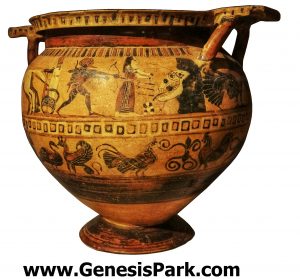 The February 26, 2000 issue of Science News contained an article that commented on a Hesione vase artifact housed at the Boston Museum of Fine Arts (Hesman, 2000). On this ancient Greek vase are a series of somewhat unusual paintings, including one that portrays a monster with the head of a dinosaur. This pottery was created around 550 B.C. and depicts the Greek hero Herakles rescuing Hesione from this “Monster of Troy.” Forced to concede that it is an amazingly realistic dinosaurian depiction, Science News concluded that the paintings on this unusual vase simply prove that ancient people dug up and assembled fossils. But there is no evidence for such sophisticated Ancient Paleontologists.
The February 26, 2000 issue of Science News contained an article that commented on a Hesione vase artifact housed at the Boston Museum of Fine Arts (Hesman, 2000). On this ancient Greek vase are a series of somewhat unusual paintings, including one that portrays a monster with the head of a dinosaur. This pottery was created around 550 B.C. and depicts the Greek hero Herakles rescuing Hesione from this “Monster of Troy.” Forced to concede that it is an amazingly realistic dinosaurian depiction, Science News concluded that the paintings on this unusual vase simply prove that ancient people dug up and assembled fossils. But there is no evidence for such sophisticated Ancient Paleontologists.
A 1971 landslide in the Girifalco region of southern Italy brought to light hundreds of ancient artifacts of a pre-Greek civilization. A lawyer named Mario Tolone Azzariti asserts that he found some dinosaurian representations among them (pictured below). To the left is a terracotta statue measuring about 18 cm long, shaped remarkably like a Stegosaurus dinosaur. The triangular plates run down its back to the creature’s tail.
In the view from above (center) the object reveals a strange curving of the plates, as if the animal had been represented lumbering from side to side. The legs are large and awkward, as if carrying great weight, not at all like those of a lizard. There is also a clear representation of a Stegosaurus on a piece of broken pottery (right).
The artifact below is a Mesopotamian jasper cylinder seal from the Uruk Period (about 3500 BC). This object is currently housed at the Louvre. The animal on the right is an artist’s conception of an Apatosaurus.  There are many striking similarities between these two depictions. The long neck, tail, legs and feet on the artifact clearly fit the sauropods better than any other type of animal. The biggest difference is at the head. Cartilage forming the shape of a frill or ears may be stylized or accurate (since there is no way to know from the skeletons we have today). As for the musculature, the ancient artist draws with stunning realism. One has to ask where the artist got the model to draw so convincingly the trunk of a sauropod.
There are many striking similarities between these two depictions. The long neck, tail, legs and feet on the artifact clearly fit the sauropods better than any other type of animal. The biggest difference is at the head. Cartilage forming the shape of a frill or ears may be stylized or accurate (since there is no way to know from the skeletons we have today). As for the musculature, the ancient artist draws with stunning realism. One has to ask where the artist got the model to draw so convincingly the trunk of a sauropod.
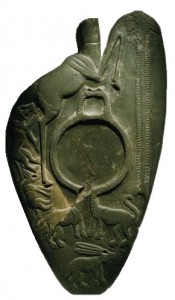 The January 2003 issue of National Geographic magazine presents an artifact described as a “cosmetic palette . . . from a cemetery of the first dynasties in Manshaat Ezzat.” These long-necked creatures displayed on page 78 fit the pattern of other ancient dinosaur-like depictions, including arching, muscular necks and stout bodies. This artifact depicts many lifelike animals (including a giraffe on the reverse).
The January 2003 issue of National Geographic magazine presents an artifact described as a “cosmetic palette . . . from a cemetery of the first dynasties in Manshaat Ezzat.” These long-necked creatures displayed on page 78 fit the pattern of other ancient dinosaur-like depictions, including arching, muscular necks and stout bodies. This artifact depicts many lifelike animals (including a giraffe on the reverse).

 To the far right is displayed the Narmer Palette, which dates back to about 3,100 BC. It is from the ancient Egyptian capital of Hierakonpolis and shows the triumph of King Nar-mer with long necked dragons that appear to be in captivity. Immediately to the right is the Two Dog Palette from the same period. It is displaying a pair of “dinosaur-like” creatures along with numerous clear representations of living animals (clearly not drawn to scale).
To the far right is displayed the Narmer Palette, which dates back to about 3,100 BC. It is from the ancient Egyptian capital of Hierakonpolis and shows the triumph of King Nar-mer with long necked dragons that appear to be in captivity. Immediately to the right is the Two Dog Palette from the same period. It is displaying a pair of “dinosaur-like” creatures along with numerous clear representations of living animals (clearly not drawn to scale).
An Egyptian apotropaic wand (or magical “knife”) dating from about 1750 BC displays a similar long-necked creature. Made from hippo tusk ivory, this artifact is currently housed in the British Museum. The preponderance of these long-necked depictions in ancient art motivated archaeologists who do not believe men and dinosaurs coexisted to invent a name for this particular creature. It is called a “serpopard,” supposedly a mosaic of a serpent and a leopard. But for those who believe that man was created in the beginning alongside the great reptiles, these palettes seem to be an attempt to depict a sauropod dinosaur. Note the “Four Dogs Palette” with the “serpopard” cut out for clarity.
 To the left is a beautiful mosaic that was one of the wonders of the second century world. (Click to enlarge or see The Nile Mosaic of Palestrina for more details). Housed in Palestrina, which is just south of Rome, this masterpiece depicts Nile scenes from Egypt all the way up into Ethiopia. Scholars now believe this is the work of Demetrius the Topographer, an artist from Alexandria who came to work in Rome. The top portion of this remarkable piece of art is generally believed to depict African animals being hunted by black-skinned warriors. These Ethiopians are pursuing what appears to be some type of dinosaur. The Greek Letters above the reptilian animal in question are KROKODILOPARDALIS, which is literally translated Crocodile-Leopard (apparently identifying an agile reptilian creature). The picture shown here is only a small portion of the massive mosaic. It also contains clear depictions of known animals, including Egyptian crocodiles and hippos.
To the left is a beautiful mosaic that was one of the wonders of the second century world. (Click to enlarge or see The Nile Mosaic of Palestrina for more details). Housed in Palestrina, which is just south of Rome, this masterpiece depicts Nile scenes from Egypt all the way up into Ethiopia. Scholars now believe this is the work of Demetrius the Topographer, an artist from Alexandria who came to work in Rome. The top portion of this remarkable piece of art is generally believed to depict African animals being hunted by black-skinned warriors. These Ethiopians are pursuing what appears to be some type of dinosaur. The Greek Letters above the reptilian animal in question are KROKODILOPARDALIS, which is literally translated Crocodile-Leopard (apparently identifying an agile reptilian creature). The picture shown here is only a small portion of the massive mosaic. It also contains clear depictions of known animals, including Egyptian crocodiles and hippos.
The picture above (on right) was drawn by North American Anasazi Indians that lived in the area that has now become Utah between 150 B.C. and 1200 A.D. Even noted anti-creationists agree that it resembles a dinosaur and that the brownish film which has hardened over the picture, along with the pitting and weathering, attests to its age. One evolutionist wrote, “There is a petroglyph in Natural Bridges National Monument that bears a startling resemblance to a dinosaur, specifically a Brontosaurus, with a long tail and neck, small head and all.” (Barnes, Fred A., and Pendleton, Michaelene, Prehistoric Indians: Their Cultures, Ruins, Artifacts and Rock Art, 1979, p.201.) Clearly a native warrior (on the left above the dinosaurian figure) and an Apatosaur-like creature are depicted in this carving located near Lake Powell, UT. Another Native American rock pictograph found in a Utah’s White Canyon region (upper left) also seems to depict a sauropod dinosaur.
The petroglyph above to the left was discovered in 2012 by Jeremy Springfield on a trip to Hidden Mountain, just outside of Los Lunas, New Mexico. S8int website brought his story to our attention. The drawing is located on an isolated, inaccessible ledge near a very clear deer petroglyph. What were the ancient Pueblo peoples intending to depict, if not a living dinosaurian creature that they knew from that region?
The Mississippian culture flourished from 800 – 1500 AD through the southwestern United States and it is known for their building of mounds. Above in the center is a curious piece from this culture (click to enlarge). Apparently the swirling pattern on its sides signifies that the animal in question lived in water, while the eye markings allude to the beast’s unusually keen vision. Some of these Indian depictions of this rotund animal show tridactyl feet, a long neck and prominent tail held aloft. Above to the right, note the handle on a Mesoamerican pottery object made by Mississippi Caddo Indians. It seems to display a baby dinosaur. This circa 1200 AD artifact is housed at Creation Evidence Museum in Texas (click to enlarge).
 Henry Rowe Schoolcraft was a geologist and Indian agent who wrote extensively about the Sioux Indians. He heard stories about a monstrous creature called Unktehi, something like an ox but much larger, with great horns. Schoolcraft reproduced drawings of several types of Unktehi monsters on birchbark around 1850. These were based upon rock art describing a war party of five canoes crossing Lake Superior that encountered animals resembling giant turtles, snakes, and moose. But some (upper right) clearly look dinosaurian. Sioux Indians further west, when interviewed by ethnologists, described Unktehi as an immense reptile or serpent with legs. He was shaped like a giant scaly snake with feet and a notched backbone or crest like a giant saw and had a heavy spiked tail. Still other
Henry Rowe Schoolcraft was a geologist and Indian agent who wrote extensively about the Sioux Indians. He heard stories about a monstrous creature called Unktehi, something like an ox but much larger, with great horns. Schoolcraft reproduced drawings of several types of Unktehi monsters on birchbark around 1850. These were based upon rock art describing a war party of five canoes crossing Lake Superior that encountered animals resembling giant turtles, snakes, and moose. But some (upper right) clearly look dinosaurian. Sioux Indians further west, when interviewed by ethnologists, described Unktehi as an immense reptile or serpent with legs. He was shaped like a giant scaly snake with feet and a notched backbone or crest like a giant saw and had a heavy spiked tail. Still other  Indian reports describe Unktehi as a swamp-dwelling creature. Adrienne Mayor, an evolutionist, believes that the Sioux were weaving stories about fossils they encountered. (Mayor, Fossil Legends of the First Americans, 2005, pp. 235-237.) But the pictures and description bring to mind the dinosaur Ankylosaurus (lower right) with a low slung body, long tail, heavy armor, and prominent multiple horns. A plated and horned creature has also been discovered in Ojibwa Indian art (left – click to enlarge) on the Agawa Rock at Misshepezhieu, Lake Superior Provincial Park, Ontario, Canada.
Indian reports describe Unktehi as a swamp-dwelling creature. Adrienne Mayor, an evolutionist, believes that the Sioux were weaving stories about fossils they encountered. (Mayor, Fossil Legends of the First Americans, 2005, pp. 235-237.) But the pictures and description bring to mind the dinosaur Ankylosaurus (lower right) with a low slung body, long tail, heavy armor, and prominent multiple horns. A plated and horned creature has also been discovered in Ojibwa Indian art (left – click to enlarge) on the Agawa Rock at Misshepezhieu, Lake Superior Provincial Park, Ontario, Canada.
 On the right is shown a photo of one of the curious “dinosaur” petroglyphs near Middle Mesa at the Wupatki National Park. This particular petroglyph is called “Puff the Magic Dragon,” and appears to be a depiction of a fire-breathing dinosaur. Though there is no certain way to date such petroglyphs, this carving is believed to be at least several hundred years old.
On the right is shown a photo of one of the curious “dinosaur” petroglyphs near Middle Mesa at the Wupatki National Park. This particular petroglyph is called “Puff the Magic Dragon,” and appears to be a depiction of a fire-breathing dinosaur. Though there is no certain way to date such petroglyphs, this carving is believed to be at least several hundred years old.
 On two occasions in the late 1800s, Samuel Hubbard, Curator of Archaeology of the Oakland Museum, visited an area of the Grand Canyon known as the Havasupai Canyon. As an evolutionist, he was amazed to find a petroglyph (carved rock drawing) of an elephant made by Native Americans. But another depiction was “cut into the sandstone much more deeply than the elephant.” Its height was 11.2 inches, with a neck approximately 5.1 inches in length and a tail of 9.1 inches. Hubbard photographed the petroglyph and eventually placed it in his scientific monograph Discoveries Relating to Prehistoric Man (1925, p. 10). What kind of animal is it? Dr. Hubbard believed that he had found an ancient drawing of a dinosaur. He wrote, “The fact that some prehistoric man made a pictograph of a dinosaur on the walls of this canyon upsets completely all of our theories regarding the antiquity of man. Facts are stubborn and immutable things. If theories do not square with the facts then the theories must change, the facts remain.” (Doheny, E. L., Discoveries Relating to Prehistoric Man by the Doheny Scientific Expedition in the Hava Supai Canyon Northern Arizona, 1924, p. 5.) In the far left picture, Paul Taylor compares this ancient drawing to the Edmontosaurus. (Click to enlarge the picture – courtesy of Don Patton.)
On two occasions in the late 1800s, Samuel Hubbard, Curator of Archaeology of the Oakland Museum, visited an area of the Grand Canyon known as the Havasupai Canyon. As an evolutionist, he was amazed to find a petroglyph (carved rock drawing) of an elephant made by Native Americans. But another depiction was “cut into the sandstone much more deeply than the elephant.” Its height was 11.2 inches, with a neck approximately 5.1 inches in length and a tail of 9.1 inches. Hubbard photographed the petroglyph and eventually placed it in his scientific monograph Discoveries Relating to Prehistoric Man (1925, p. 10). What kind of animal is it? Dr. Hubbard believed that he had found an ancient drawing of a dinosaur. He wrote, “The fact that some prehistoric man made a pictograph of a dinosaur on the walls of this canyon upsets completely all of our theories regarding the antiquity of man. Facts are stubborn and immutable things. If theories do not square with the facts then the theories must change, the facts remain.” (Doheny, E. L., Discoveries Relating to Prehistoric Man by the Doheny Scientific Expedition in the Hava Supai Canyon Northern Arizona, 1924, p. 5.) In the far left picture, Paul Taylor compares this ancient drawing to the Edmontosaurus. (Click to enlarge the picture – courtesy of Don Patton.)
A similar association of an American elephant and dinosaur is presented in the Granby Idol. This queer rock relic was unearthed by W.L. Chalmers near Grand Lake, high in the Colorado Rockies. He found the 66 pound stone (along with various ancient utensils) several feet below the surface while enlarging an irrigation reservoir on his homestead. The stone was made of an exceedingly hard green material, like nothing ever known of in the neighborhood. (“Is Pre-Glacial Man Coming Back?” Hutchison News, January 5, 1923.) On one side is a carved man, holding a tablet containing symbols. On the back are carved a mastodon and two dinosaurs. (Click to enlarge. Courtesy of s8int.com.) According to The Le Grand Reporter in 1923, Jean Allard Jeancon, archaeologist and Curator of the Colorado Historical and Natural History Society, stated, “If this stone can be proven genuine, it is the biggest find in all anthropological research and antedates anything on the American continent and is going to establish the remote antiquity of man. I have never seen such remarkable outlines of dinosaurs and mastodons!” Unfortunately this priceless artifact appears to have been lost somewhere in the bowels of the museum system. (Murphy, Jan, Mysteries and Legends of Colorado: True Stories of the Unsolved and Unexplained, 2007.) If a school teacher named Lela Smith had not taken three photos of the Buddha-like stone, the knowledge of this relic would have been lost.
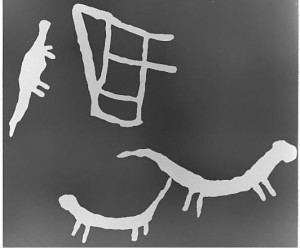
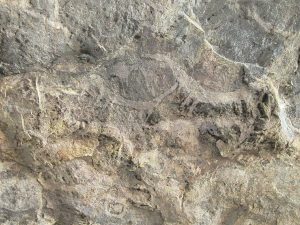 “A fantastic mystery has developed over a set of cave paintings found in the Gorozomzi [sic] Hills, 25 miles from Salisbury [renamed Harare]. For the paintings include a brontosaurus – the 67-foot, 30-ton-like creature scientists believed became extinct millions of years before man appeared on earth. Yet the bushmen who did the paintings ruled Rhodesia [modern Zimbabwe] from only 1500 BC until a couple of hundred years ago. And the experts agree that the bushmen always painted from life experiences. This belief is borne out by other Gorozomzi Hills cave paintings – accurate representations of the elephant, hippo, buck and giraffe. The mysterious pictures were found by Bevan Parkes, who owns the land the caves are on. Adding to the puzzle of the rock paintings found by Parkes is a drawing of a dancing bear.” (Anonymous, “Bushmen’s Paintings Baffling to Scientists,” Los Angeles Herald-Examiner, January 7, 1970.) To the left is a reproduction of similar rock paintings from a cave at Nachikufu near Mpika in Zambia (formerly Northern Rhodesia). It shows three long-necked, long-tailed creatures painted in a dirty white. The best images were obtained by using ultra-violet photography. (Cooke and Clark, Prehistoric Rock Art of the Federation of Rhodesia & Nyasaland, edited by Roger Summers, 1959, pp. 191-194.)
“A fantastic mystery has developed over a set of cave paintings found in the Gorozomzi [sic] Hills, 25 miles from Salisbury [renamed Harare]. For the paintings include a brontosaurus – the 67-foot, 30-ton-like creature scientists believed became extinct millions of years before man appeared on earth. Yet the bushmen who did the paintings ruled Rhodesia [modern Zimbabwe] from only 1500 BC until a couple of hundred years ago. And the experts agree that the bushmen always painted from life experiences. This belief is borne out by other Gorozomzi Hills cave paintings – accurate representations of the elephant, hippo, buck and giraffe. The mysterious pictures were found by Bevan Parkes, who owns the land the caves are on. Adding to the puzzle of the rock paintings found by Parkes is a drawing of a dancing bear.” (Anonymous, “Bushmen’s Paintings Baffling to Scientists,” Los Angeles Herald-Examiner, January 7, 1970.) To the left is a reproduction of similar rock paintings from a cave at Nachikufu near Mpika in Zambia (formerly Northern Rhodesia). It shows three long-necked, long-tailed creatures painted in a dirty white. The best images were obtained by using ultra-violet photography. (Cooke and Clark, Prehistoric Rock Art of the Federation of Rhodesia & Nyasaland, edited by Roger Summers, 1959, pp. 191-194.)
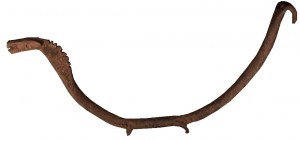 The Bambara peoples of Mali Africa created wonderful wood and iron figurines in the 1800s. Humans, horses, antelopes, and much more are beautifully portrayed. To the right is an iron figure that was entitled “dinosaurian sculpture” by the auctioning gallery. It shows a four-legged creature with long neck and tail like a sauropod dinosaur. The neck has a slight widening and a ridged frill that makes it an especially fascinating depiction. The iron piece is actually a functional tool, with a hook at the end, perhaps used to retrieve a hot pot off the fire.
The Bambara peoples of Mali Africa created wonderful wood and iron figurines in the 1800s. Humans, horses, antelopes, and much more are beautifully portrayed. To the right is an iron figure that was entitled “dinosaurian sculpture” by the auctioning gallery. It shows a four-legged creature with long neck and tail like a sauropod dinosaur. The neck has a slight widening and a ridged frill that makes it an especially fascinating depiction. The iron piece is actually a functional tool, with a hook at the end, perhaps used to retrieve a hot pot off the fire.
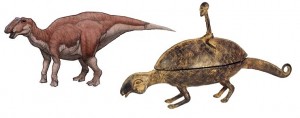 Another African tribe from the Mali region produced a dinosaurian object in the mid-1800s. Our friends at the s8int website note that this is the same time frame when Sir Richard Owen coined the term “dinosaur” in England. The bronze artifact to the left shows a Dogon tribesman riding a long-necked, long-tailed reptilian creature. The oddly bird-like head with strong jawline and ridged head and neck are reminiscent of certain “duck-billed” ornithopod dinosaurs like the hadrosaur Gryposaurus, whose skeleton is found in the Kaiparowits Formation in Utah. The diamond-shaped pattern on the skin matches fossilized skin impressions discovered on a hadrosaur in southern Utah. The sizes of the Dogon rider and the large-nosed Gryposaurus are modeled roughly in correct proportion.
Another African tribe from the Mali region produced a dinosaurian object in the mid-1800s. Our friends at the s8int website note that this is the same time frame when Sir Richard Owen coined the term “dinosaur” in England. The bronze artifact to the left shows a Dogon tribesman riding a long-necked, long-tailed reptilian creature. The oddly bird-like head with strong jawline and ridged head and neck are reminiscent of certain “duck-billed” ornithopod dinosaurs like the hadrosaur Gryposaurus, whose skeleton is found in the Kaiparowits Formation in Utah. The diamond-shaped pattern on the skin matches fossilized skin impressions discovered on a hadrosaur in southern Utah. The sizes of the Dogon rider and the large-nosed Gryposaurus are modeled roughly in correct proportion.
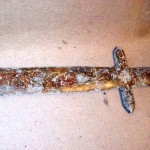 In the 1920s thirty-one Roman-style lead artifacts were excavated near Tucson, AZ (see right). These are described on p. 331 of David Hatcher’s book The Lost Cities of North & Central America and were featured on the History Channel’s 2013 show America Unearthed. These lead objects appear to be religious in nature with Hebrew and Latin inscribed upon the swords, spears and crosses. They were buried about five feet below the desert surface in a layer of caliche (a cement-like mixture of desert soil and minerals). Skeptics have questioned the authenticity of these artifacts because the discovery site contains no other artifacts (like pottery, broken glass, bones, ashes or houses) that might validate the existence of Medieval colony. But perhaps this location was merely a ceremonial storage location. Supporters point out the value of the significant amount of burial work and expensive lead involved and wonder what the motivation could be for such an elaborate hoax? After all, just one cross weighs 62 pounds!
In the 1920s thirty-one Roman-style lead artifacts were excavated near Tucson, AZ (see right). These are described on p. 331 of David Hatcher’s book The Lost Cities of North & Central America and were featured on the History Channel’s 2013 show America Unearthed. These lead objects appear to be religious in nature with Hebrew and Latin inscribed upon the swords, spears and crosses. They were buried about five feet below the desert surface in a layer of caliche (a cement-like mixture of desert soil and minerals). Skeptics have questioned the authenticity of these artifacts because the discovery site contains no other artifacts (like pottery, broken glass, bones, ashes or houses) that might validate the existence of Medieval colony. But perhaps this location was merely a ceremonial storage location. Supporters point out the value of the significant amount of burial work and expensive lead involved and wonder what the motivation could be for such an elaborate hoax? After all, just one cross weighs 62 pounds!  Microscopic analysis of the mineralization build up on the implements seems to argue for them being genuine. A 1972 attempt to dig on location to search for additional objects was curtailed due to legal challenges. But one of the biggest objections to the authenticity of the Tucson Silverbell artifacts is the precise carvings of an apparent Diplodocus dinosaur on the sword (click right to see it highlighted). The artifacts have been stored at the Arizona Historical Society.
Microscopic analysis of the mineralization build up on the implements seems to argue for them being genuine. A 1972 attempt to dig on location to search for additional objects was curtailed due to legal challenges. But one of the biggest objections to the authenticity of the Tucson Silverbell artifacts is the precise carvings of an apparent Diplodocus dinosaur on the sword (click right to see it highlighted). The artifacts have been stored at the Arizona Historical Society.
 To the left are pictured Ica Ceremonial Burial Stones from the Nasca culture (100 BC to 800AD) that are carved in a bas relief technique. In 1500s the Spanish Conquistadors brought back stories that there were stones with strange creatures carved on them found in Peru. Some of the stones were even brought back to Spain. The Incan Chronicler Juan de Santa Cruz Pachucuti Lumqui wrote in 1571 about the strange engraved stones in Ica. (See Swift, Dennis, Secrets of the Ica Stones, 2006.) Dom Geronomo Cabrera was a Spanish conquistador who settled the area of Ica in 1570. One of his descendants, Dr. Javier Cabrera, saw these stones as a child and began collecting them in the 1960s. He eventually accumulated thousands of stones. Retired from the University of Lima, Dr. Cabrera focused upon validating these finds within the scientific community. His credibility was strengthened by the discovery of ancient ceramics that display long-necked, reptilian creatures. This pottery is currently displayed in the museum of Lima (lower right).
To the left are pictured Ica Ceremonial Burial Stones from the Nasca culture (100 BC to 800AD) that are carved in a bas relief technique. In 1500s the Spanish Conquistadors brought back stories that there were stones with strange creatures carved on them found in Peru. Some of the stones were even brought back to Spain. The Incan Chronicler Juan de Santa Cruz Pachucuti Lumqui wrote in 1571 about the strange engraved stones in Ica. (See Swift, Dennis, Secrets of the Ica Stones, 2006.) Dom Geronomo Cabrera was a Spanish conquistador who settled the area of Ica in 1570. One of his descendants, Dr. Javier Cabrera, saw these stones as a child and began collecting them in the 1960s. He eventually accumulated thousands of stones. Retired from the University of Lima, Dr. Cabrera focused upon validating these finds within the scientific community. His credibility was strengthened by the discovery of ancient ceramics that display long-necked, reptilian creatures. This pottery is currently displayed in the museum of Lima (lower right).
Beautiful tapestries (see above) have also been found in the tombs of the area (dated from 200 – 700 AD) with a repeating pattern that looks like dinosaurs (pictures courtesy of Dennis Swift). Indeed, the depictions on some of the Ica Stones show the sauropod dinosaurs with a crest of spines much like those on the Acambaro figures, and preserved skin remains discovered by Paleontologist Stephen Czerkas:“Recent discovery of fossilized sauropod (diplodocid) skin impressions reveals a significantly different appearance for these dinosaurs. The fossilized skin demonstrates that a median row of spines was present… Some are quite narrow, and others are broader and more conical.” (Czerkas, “New Look for Sauropod Dinosaurs,” Geology, December, 1992, p. 1,068.)
Also, of interest is the fact that the skin of many of the carved dinosaurs has rounded, bump-like depictions. Some scientists had pointed to this as evidence that this stone art is not scientifically accurate. However, more recent discoveries of fossilized dinosaur skin and embryos have silenced these same critics. For example, Luis Chiappe and colleagues discussed certain sauropod dinosaur embryos found in South America: “The general skin pattern consists of round, non-overlapping, tubercle-like scales…A rosette pattern of scales is present in PVPH-130″ (Chiappe, et al., 1998, p. 259). Note the skin depictions above to the right. “Both taxa show a round pattern of small polygonal scales, which in some places is interrupted by larger oval tubercles surrounded by the small scales, resulting in rosette-like structures. …which also match the most common textures known in dinosaurs.” (Christiansen, and Tschopp, “Exceptional Stegosaur Integument Impressions from the Upper Jurassic Morrison Formation of Wyoming,” Swiss Journal of Geosciences 103:2, 2010.)
Other items of anatomical accuracy that attest to the authenticity of these Ica Stone depictions include the positioning of the tail and legs. Early critics said the Ica Stones were fakes, in part because their tails were almost all sticking out while walking. Paleontologists in the 1960s were confident that dinosaurs dragged their tails. The paleontologists were wrong and the Ica Stones were right.  Scientists now believe dinosaurs held their massive tails off the ground while walking, because there are no drag marks on dinosaur trackways. The dinosaurs on the Ica Stones are accurately depicted standing upright, rather than with legs splayed out in a lizard-like position. The stylizing of animals depicted on the Ica Stones matches those found in the Nascan Lines (monkey with curled tail, hummingbird, and stylized dinosaur).
Scientists now believe dinosaurs held their massive tails off the ground while walking, because there are no drag marks on dinosaur trackways. The dinosaurs on the Ica Stones are accurately depicted standing upright, rather than with legs splayed out in a lizard-like position. The stylizing of animals depicted on the Ica Stones matches those found in the Nascan Lines (monkey with curled tail, hummingbird, and stylized dinosaur).  Many of the Ica Stones were been blackened so that the artistic etchings stand out. Undoubtedly, many fraudulent Ica Stones have been manufactured over the years to sell to tourists. But dinosaur stones were found in tomb excavations by experienced archaeologists. Moreover microscopic analysis of the patina (covering the stone surface), copper traces and oxidation in the etching grooves helps distinguish between the authentic and the recently forged artifacts. In 2015-2016 Genesis Park participated in research seeking a methodology to independently authenticate the Ica Stones. This resulted in an article published in a peer-reviewed creation science journal.
Many of the Ica Stones were been blackened so that the artistic etchings stand out. Undoubtedly, many fraudulent Ica Stones have been manufactured over the years to sell to tourists. But dinosaur stones were found in tomb excavations by experienced archaeologists. Moreover microscopic analysis of the patina (covering the stone surface), copper traces and oxidation in the etching grooves helps distinguish between the authentic and the recently forged artifacts. In 2015-2016 Genesis Park participated in research seeking a methodology to independently authenticate the Ica Stones. This resulted in an article published in a peer-reviewed creation science journal.
Sauropod dinosaurs have also been found on ceramics from this same Peruvian region. The Nazcan vases above are from Dennis Swift’s personal collection. These artifacts show a less stylized and very realistic looking dinosaurian with large eyes. One has a dermal frill and the other does not. This may have been a sexual dimorphism (perhaps a gender-specific trait in males). The image on the right hand pot was digitally combined by Richard Dobbs (click to enlarge).
Not far from the South American Nasca sites are the Moche Indian archaeological locations. These Moche tribes inhabited northern Peru about 100-800 AD. Among the artifacts currently in the Lima museums are the Moche stirrup-spout pots (left). These are their main artistic medium, featuring red & white ceramic pots displaying realistic medical procedures, combative events, musical instruments, plants and animals. Official guides at Peru’s numerous museums and archaeological sites will tell you that the native cultures depicted only things that they saw in nature. So what inspired the dragon-like images like that on the canchero to the right? In Lima’s Larco Museum there are numerous ancient vases that quite clearly depict long-necked reptilian monsters with three or four toes, in some cases carrying a trophy head on their tail. These creatures bear a resemblance to those shown on the Ica stones, including the dermal frills. They have been dubbed “Strombus Monsters” because they are sometimes shown hiding in a Strombus shell. (Note the Moche pot on the left. Both this piece and the canchero are part of the Genesis Park collection.)
The three images above are also Peruvian (click to enlarge). To the left is a Moche pot that beautifully depicts a large reptilian form, similar to what is shown on many of the burial cloths. In the center is a gold artifact that resembles a toothy theropod dinosaur. It is housed in the Museo Oro del Peru in Lima. To the right is a Paracas pot that shows a ferocious dinosaurian image with a dermal crest going down the trunk and tail.
 A dictionary (Casamiquela, R., Diccionario Tehuelche, Va. Adelina: Patagonia Sur Libros, 2008.) on the language of the Patagonian natives (the Tehuelche groups) by the late historian Rodolfo Casamiquela displays a 16th century map (right). It depicts terrain of the Terra Magellanica (what is now Argentina) and shows a hunting party shooting at a ñandú and also displays some very dinosaurian-looking animals up above. Click to enlarge and look top center and to the right.
A dictionary (Casamiquela, R., Diccionario Tehuelche, Va. Adelina: Patagonia Sur Libros, 2008.) on the language of the Patagonian natives (the Tehuelche groups) by the late historian Rodolfo Casamiquela displays a 16th century map (right). It depicts terrain of the Terra Magellanica (what is now Argentina) and shows a hunting party shooting at a ñandú and also displays some very dinosaurian-looking animals up above. Click to enlarge and look top center and to the right.

 The ancient Maya culture, which flourished around the 6th century, is famous for their excellent artwork. Bonampak is a Maya archaeological site in Mexico where there are a number of wonderful murals, including the remarkable one to the left. It shows the presentation of various war captives to the ruler, Chaan Muan, along with some trophy heads (perhaps brought for sacrificing). In addition to the human heads, the men are carrying an animal head and what looks a lot like a dinosaur head (enlarged in the picture to the right). Both the teeth and the large size make it doubtful that the Maya artist was depicting a lizard or snake.
The ancient Maya culture, which flourished around the 6th century, is famous for their excellent artwork. Bonampak is a Maya archaeological site in Mexico where there are a number of wonderful murals, including the remarkable one to the left. It shows the presentation of various war captives to the ruler, Chaan Muan, along with some trophy heads (perhaps brought for sacrificing). In addition to the human heads, the men are carrying an animal head and what looks a lot like a dinosaur head (enlarged in the picture to the right). Both the teeth and the large size make it doubtful that the Maya artist was depicting a lizard or snake.
In 1945 Waldemar Julsrud, a resident of Acambaro, Mexico who had archaeological experience, discovered clay figurines buried at the foot of El Toro Mountain. Eventually over 33,000 ceramic and stone figurines were found! These range from detailed artwork, to whistles and musical instruments, to roughly-shaped animal depictions, to monstrous creatures. There are clear similarities to Chupicuaro Cultural artifacts (800 BC to 200 AD) found in the area, a culture that Julsrud co-discovered.


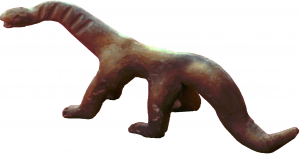
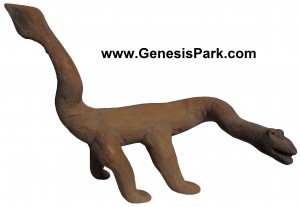 But the authenticity of Julsrud’s find has been challenged because the huge collection included clear dinosaur figurines. In 1954 the Mexican government sent a team of archaeologists to investigate. In 1955 Charles Hapgood, Professor of Anthropology at the University of New Hampshire, conducted an elaborate investigation including radiometric dating and thermo-luminescence testing by the University of Pennsylvania. Subsequent investigations were conducted by the Mexican government. Thus Julsrud’s work has undergone considerable scrutiny. The Mexican
But the authenticity of Julsrud’s find has been challenged because the huge collection included clear dinosaur figurines. In 1954 the Mexican government sent a team of archaeologists to investigate. In 1955 Charles Hapgood, Professor of Anthropology at the University of New Hampshire, conducted an elaborate investigation including radiometric dating and thermo-luminescence testing by the University of Pennsylvania. Subsequent investigations were conducted by the Mexican government. Thus Julsrud’s work has undergone considerable scrutiny. The Mexican 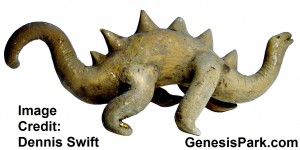 government even imprisoned men for selling these artifacts on the black market. Moreover, the dinosaurs are modeled in very agile, active poses, fitting well with the latest scientific evidence and lending credence to the artists having actually observed these creatures. Like the Ica Stones, some sauropod’s are depicted with a distinctive spinal frill. The remains of an ice-age horse (now extinct), the unfossilized skeleton of a woolly mammoth, and a number of ancient human skulls were found at the same location as the ceramic artifacts, validating the antiquity of the site (Hapgood, Charles, Mystery in Acambaro, 2000, p.82.). Dr. Ivan T. Sanderson was amazed in 1955 to find that there was an accurate representation of a Brachiosaurus, almost totally unknown to the general public at that time. Sanderson wrote, “This figurine is a very fine, jet-black, polished-looking ware. It is about a foot tall. The point is it is an absolutely perfect representation of Brachiosaurus, known only from East Africa and North America. There are a number of outlines of the skeletons in the standard literature but only one fleshed out reconstruction that I have ever seen. This is exactly like it.” (Hapgood, p. 85.)
government even imprisoned men for selling these artifacts on the black market. Moreover, the dinosaurs are modeled in very agile, active poses, fitting well with the latest scientific evidence and lending credence to the artists having actually observed these creatures. Like the Ica Stones, some sauropod’s are depicted with a distinctive spinal frill. The remains of an ice-age horse (now extinct), the unfossilized skeleton of a woolly mammoth, and a number of ancient human skulls were found at the same location as the ceramic artifacts, validating the antiquity of the site (Hapgood, Charles, Mystery in Acambaro, 2000, p.82.). Dr. Ivan T. Sanderson was amazed in 1955 to find that there was an accurate representation of a Brachiosaurus, almost totally unknown to the general public at that time. Sanderson wrote, “This figurine is a very fine, jet-black, polished-looking ware. It is about a foot tall. The point is it is an absolutely perfect representation of Brachiosaurus, known only from East Africa and North America. There are a number of outlines of the skeletons in the standard literature but only one fleshed out reconstruction that I have ever seen. This is exactly like it.” (Hapgood, p. 85.)
Further evidence of the authenticity of Julsrud’s finds is a figurine that resembles the Iguanodon dinosaur figurine (above left, photo credit – Don Patton). This was one of the first dinosaur skeletons discovered. The early concept of its appearance was almost comical in the mid 1800s. By the turn of the century it had improved considerably but fell far short of what we now know. The Acambaro figurine exhibits knowledge we have gained only in recent decades. No hoaxer could have made this model in the 1940s. In fact, there is a movement in recent years to “slenderize” the sauropod dinosaurs, suggesting that they were more agile and less plump (much like the Acambaro figures). For example, in 2009 scientists “devised a new statistical model that can more accurately predict the mass of an animal based on the width of its bones” resulting in a downsizing of Apatosaurus, which had “been widely cited as weighing about 42 tons. According to the new equation, these creatures actually weighed about 20 tons, or less than half earlier estimates.” (Moskowitz, Clara, “Giant Dinosaurs Get Downsized,” Live Science, December 12, 2009.) Other recognizable Acamabaro shown above include figures are the Tyrannosaurus-like theropod figurine and the Ankylosaurus statue. The beak on this figurine is slightly broken off, but the distinct horns, short neck, dermal spikes, pudgy feet and powerful tail are all nicely replicated. (Both of these pieces are in the Genesis Park collection.) Genesis Park staff participated in research on Mount Toro in Acambaro where most of these artifacts have been excavated. Many figurines remain buried in the ground there and new pieces are regularly being exposed as a result of erosion, construction work, and farming.
 To the left is an artifact from Tiwanaku, an important Pre-Columbian archaeological site in Bolivia. Tiwanaku is recognized by Andean scholars as one of the most important precursors to the Inca Empire. The vase depicts dueling dinosaurs and is believed to date from 500 – 1000 A.D. The style closely resembles the Nasca dinosaurian depictions (on the Ica Stones).
To the left is an artifact from Tiwanaku, an important Pre-Columbian archaeological site in Bolivia. Tiwanaku is recognized by Andean scholars as one of the most important precursors to the Inca Empire. The vase depicts dueling dinosaurs and is believed to date from 500 – 1000 A.D. The style closely resembles the Nasca dinosaurian depictions (on the Ica Stones).
In May of 2012 researcher Vance Nelson brought to our attention a panel of pictographs found on a rock ledge at the edge of the Amazon rain forest basin near Yamon in the northern province of Utcabamba, Perú. This artwork is said by secular archaeologists to be thousands of years old. Amazingly, one of the pictographs shows nine warriors hunting what appears to be a dinosaur. In the 1940s the American explorer Percy Fawcett brought back reports of a large dinosaur-like creature from this same region of the Amazon.
The Ashanti people of Ghana in western Africa are known for their bronze carvings that were used over the centuries as gold weights (used along with a scale in the gold dust trade). Eventually, these little statues became a bit of an art form and many accurately depict various African animals. The curious gold weight to the left dates back to the 1800s and is now part of the Penn Museum collection in Philadelphia (Image #AF2478 commissioned by Genesis Park). It was unidentified initially, “despite diligent search in the animal kingdom.” (Plass, Margaret, African Miniatures: The Goldweights of the Ashanti, 1967, p.92.) A jeweler in Philadelphia first suggested that it resembles a juvenile dinosaur. (Heuvelmans, Bernard, Les Derniers Dragons d’Afrique, 1978, pp. 336–337.) It has a fan tail and a beak-like mouth, distinctive characteristics of some of the recently-discovered oviraptorosaur fossils.
To the left is an ancient Thai incense burner pictured in the book Arts of Asia : Materials, Techniques, Styles by Meher McArthur. Curiously enough, it looks like a stylized version of a sauropod, the fossilized bones of which were actually found in Thailand. Notice the birds perched on the back of the dragon, much as we see them do today on the back of a hippo. A similar motif is seen in a Viet incense burner to the right. This cast bronze work is dated to the 3rd century A.D. and is from the Dongson culture. The piece is housed at the Boston Museum of Fine Arts.
Deep in the jungles of Cambodia are ornate temples and palaces from the Khmer civilization. One such temple, Ta Prohm, abounds with stone statues and relief art. Almost every square inch of the gray sandstone is covered with detailed carvings. These depict familiar animals like monkeys, deer, horses, elephants, water buffalo, parrots, and lizards. However, one column contains an intricate carving of a stegosaur-like creature. Note the upright posture, huge tail, and plates (lower left). But how could artisans decorating an 800 year old Buddhist temple know what a dinosaur looked like when western science only began assembling dinosaurs skeletons in the past two centuries? It seems that the Khmer artist had seen or received reports of a stegosaur. However, skeptics point to the lack of tail spikes and the over-sized head to question the stegosaur interpretation. After traveling to Ta Prohm in 2017, taking hi-res photos and measurements, and discovering a second stegosaur engraving, Genes Park staff prepared a peer-reviewed journal article on “The Stegosaur Engravings at Ta Prohm” responding to the critics.
 Medieval European art is replete with dragon iconography, much of it used to typify Satanic power (Revelation 12:3). A wonderfully-preserved fresco (on the left – click to enlarge the dragon) depicting the archangel Michael overcoming the dragon is displayed at San Zan Degolà, a beautiful little 13th century church in Venice, Italy. The dragon’s proportions and especially its diminutive front legs bring to mind the small theropod dinosaurs like Compsognathus.
Medieval European art is replete with dragon iconography, much of it used to typify Satanic power (Revelation 12:3). A wonderfully-preserved fresco (on the left – click to enlarge the dragon) depicting the archangel Michael overcoming the dragon is displayed at San Zan Degolà, a beautiful little 13th century church in Venice, Italy. The dragon’s proportions and especially its diminutive front legs bring to mind the small theropod dinosaurs like Compsognathus.
 The country of Georgia sits at the edge of Eastern Europe and Western Asia. High in the hills atop Mount Gergeti is the Holy Trinity Church (also known as Tsminda Sameba) which was originally constructed in the 1300s. The bell tower window (shown on right) contains some unusual carvings that look quite a bit like two dinosaurs, perhaps engaged in head-butting combat. Inside the church is an ancient icon of St. George slaying a snake-like dragon. St. George has been revered in the Republic of Georgia since the 4th century. The weathering and patina of these dragons certainly seems to match the rest of the construction, suggesting it is an original carving.
The country of Georgia sits at the edge of Eastern Europe and Western Asia. High in the hills atop Mount Gergeti is the Holy Trinity Church (also known as Tsminda Sameba) which was originally constructed in the 1300s. The bell tower window (shown on right) contains some unusual carvings that look quite a bit like two dinosaurs, perhaps engaged in head-butting combat. Inside the church is an ancient icon of St. George slaying a snake-like dragon. St. George has been revered in the Republic of Georgia since the 4th century. The weathering and patina of these dragons certainly seems to match the rest of the construction, suggesting it is an original carving.
Choir stall railings and misericords (shelf-like seats for reclining while standing) in Medieval European churches are often adorned with ornate carvings. A common theme is the depictions of a dragon (symbolizing Satan) fighting a lion (symbolizing Christ). Lower left is one such depiction, showing a dragon that looks very much like a sauropod dinosaur, taken from St. Remigius’ Church. Other dragon scenes are also depicted. Notice the dragon eating a man as shown on a misericord from St. David’s Cathedral in Wales. The Carlisle Cathedral’s misericords showing twin dragons were carved in the 15th century. Click to enlarge these pictures.
The slaying of a ferocious dragon by St. George is an extremely common motif in medieval art. According to the story, the fierce dragon ate all the town’s livestock and was demanding a human sacrifices. The lot fell upon the beautiful princess who then needed to save the town by giving up her life. But just before she was killed, brave George showed up, killed the dragon and rescued the princess. Various European artists interpreted the dragon differently, depending on local knowledge and lore. A wonderful medieval depiction is seen at the Palau de La Generalitat in Barcelona Spain. St. George’s Chapel contains an altar cloth illustrating St. George’s slaying of a dragon. The depiction bears an amazing likeness to the Nothosaurus, a semi-aquatic reptile (comparison below). Notice the correct-size, the crocodilian body style, and the fascinating long, curved teeth at the front of the jaw that gives way to finer dentition towards the back.
Yet another interpretation of St. George slaying the dragon is found in the Latin Book of Hours c. 1450 AD which is illuminated by the Master of Jean Chevrot and currently housed at the Morgan Library & Museum (lower left). Notice the Master’s attention to detail (click to enlarge), as seen in George’s armor, the birds in the sky, and the dragon’s genitals. The Fitzwilliam Museum contains another portrayal (lower middle left) of St. George destroying the dragon (probably by Bruges) from a Latin Book of Hours c. 1490 AD. This colorful work from the Flemish School portrays a remarkably dinosaur-like dragon. Next we present (below middle right) an illustration of George leading a defeated dragon as seen in the book Huth Hours, published in the Netherlands c. 1480 (Image from the British Library). The monster has a curiously large stomach (perhaps gravid) and is web-footed. But note the accurate reptilian ear and dinosaurian neck. Finally, below on the right is a portrayal of St George from the early 1500s courtesy of the Bibliothèque Nationale de France. The dragon’s head is rather flattened, like the snout of the baryonyx dinosaur seen below.

 Here are a couple more artistic variation of the event of St. George slaying the dragon, both from Belgium. To the left we see the famed knight of Cappadocia lancing a slender reptile featuring a prominent, long neck. What would have inspired an artist from Bruges, Belgium in the year 1440 to display the dragon in this painting with such a long neck? It doesn’t resemble any common reptiles that he would have known, like a lizard or crocodile. But it does look very much like certain kinds dinosaurs (like a juvenile Diplodocus or the small reptile Tanystropheus). To the right is an illustration from the Book of Hours by Simon Bening of Ghent. The dragon he drew is huge, on the order of a Komodo Dragon. But how could an artist in the mid 1500’s know about such a reptile? With his lance, George boldly transfixes the dragon. Around him, the ground is strewn with bones. In the distance, the Princess stands on a hill helplessly raising both hands and the King is seen watching from the Tower.
Here are a couple more artistic variation of the event of St. George slaying the dragon, both from Belgium. To the left we see the famed knight of Cappadocia lancing a slender reptile featuring a prominent, long neck. What would have inspired an artist from Bruges, Belgium in the year 1440 to display the dragon in this painting with such a long neck? It doesn’t resemble any common reptiles that he would have known, like a lizard or crocodile. But it does look very much like certain kinds dinosaurs (like a juvenile Diplodocus or the small reptile Tanystropheus). To the right is an illustration from the Book of Hours by Simon Bening of Ghent. The dragon he drew is huge, on the order of a Komodo Dragon. But how could an artist in the mid 1500’s know about such a reptile? With his lance, George boldly transfixes the dragon. Around him, the ground is strewn with bones. In the distance, the Princess stands on a hill helplessly raising both hands and the King is seen watching from the Tower.
 Another popular Medieval dragon legend involves Saint Margaret of Antioch. Stories of this young Christian martyr vary. Supposedly she lived in the 4th century AD and encountered extensive persecution for becoming a Christian. At one point, she was even attacked by a dragon, which swallowed her whole. But as she began to pray inside the reptile, the cross she wore around her neck cut into the stomach of the reptile sufficiently that she was able to pop back outside, killing the dragon. Various artistic images of this event reflect the local conceptions of dragons. Notice the dinosaurian features (right) in this illustration by a Belgian artist for a Book of Hours that is currently in New York’s Morgan Museum.
Another popular Medieval dragon legend involves Saint Margaret of Antioch. Stories of this young Christian martyr vary. Supposedly she lived in the 4th century AD and encountered extensive persecution for becoming a Christian. At one point, she was even attacked by a dragon, which swallowed her whole. But as she began to pray inside the reptile, the cross she wore around her neck cut into the stomach of the reptile sufficiently that she was able to pop back outside, killing the dragon. Various artistic images of this event reflect the local conceptions of dragons. Notice the dinosaurian features (right) in this illustration by a Belgian artist for a Book of Hours that is currently in New York’s Morgan Museum.
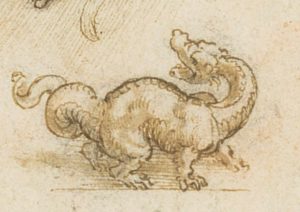 The famous Italian artist Leonardo Da Vinci was gifted in working various mediums. A pen and ink picture entitled “Cats, Lions, and a Dragon” was drawn by him circa 1517–1518. It is now part of the Royal Collection housed at Buckingham Palace. The cats are all drawn with the incredible realism and detail that comes from personal observation. The single dragon bears a remarkable likeness to a small sauropod dinosaur. But dinosaurs would not be discovered in Europe for another three centuries! What did Leonardo base his dragon drawing on? The only odd feature is the coiled tail. There is an artist’s note at the bottom of the drawing: “Of Flexion and Extension”. Perhaps there was a species of small sauropod known in the Middle Ages that could coil its tail. Or maybe the unusual tail posture was based upon reports of common lizards that can coil their tail and use it for grasping.
The famous Italian artist Leonardo Da Vinci was gifted in working various mediums. A pen and ink picture entitled “Cats, Lions, and a Dragon” was drawn by him circa 1517–1518. It is now part of the Royal Collection housed at Buckingham Palace. The cats are all drawn with the incredible realism and detail that comes from personal observation. The single dragon bears a remarkable likeness to a small sauropod dinosaur. But dinosaurs would not be discovered in Europe for another three centuries! What did Leonardo base his dragon drawing on? The only odd feature is the coiled tail. There is an artist’s note at the bottom of the drawing: “Of Flexion and Extension”. Perhaps there was a species of small sauropod known in the Middle Ages that could coil its tail. Or maybe the unusual tail posture was based upon reports of common lizards that can coil their tail and use it for grasping.
Some of the beautiful French chateaus built at the close of the Middle Ages and early 1500s have dramatic dragon illustrations carved into their walls, ceilings, and furniture. These include Château de Chambord, Château de Blois, and Château Azay-le-Rideau. Called “salamanders,” based on a legendary salamander that could survive fire, they became especially popular decorative elements on construction during the reign of Francis I. Often they are portrayed actually as a fire-breathing dragon, like the biblical Leviathan. A number of features make these “salamanders” different from the amphibians we know by that name today. They are depicted with long necks, scales, prominent teeth, powerful claws, and an upright posture. The form is much closer to the reptilian dragon depictions common in European art from that period. Note the similarities among these “salamander” dragons below and their resemblance to dinosaurs like Thecodontosaurus, Plateosaurus or Baryonyx (whose fossils are found in multiple locations around Europe). A number of royal household furnishings from that time also depict a similar dragon, like the antique French pot below to the right. A tapestry at Château de Blois portrays a dragon (and its baby) with gnarly horns on its head that are reminiscent of the dinosaur Dracorex hogwartsia. [Photo credit: Don Patton.]
In Rome there is similar artwork on the outside at the Church of St. Louis of the French. This served for many years as the national church of France in Rome and was completed in the 1580s. Notice on the dragon artwork (to the left) the long neck, tridactyl feet, long tail, neck frill, the scales, and especially the dinosaurian-looking legs. They drop down straight, rather than being splayed out parallel to the ground like a salamander or lizard’s legs. Though exposed to the elements on the exterior of the church, the detailed work has been remarkably well preserved over nearly five centuries! Click to enlarge this amazing dragon carving.

 In 1496 the Bishop of Carlisle, Richard Bell, was buried in Carlisle Cathedral in far northern England, near the Scottish border. The tomb (see far right) is inlaid with brass, having various animals engraved upon it. Although worn by the countless feet that walked over it since the Middle Ages, a particular depiction is intriguing in its similarity to a sauropod dinosaur. It appears to be two long-necked dinosaurs with necks entangled like the Egyptian Hierakonpolis dragon depictions mentioned above (perhaps an amorous posture). The long tails stick out straight like an Apatosaurus and one (maybe the male) sports spikes at the end. Spikes on sauropods was unknown until fairly recently. In 1989 paleontologists realized that Shunosaurus had a club with four backwards-facing spikes at the end of its tail. In 2009 the long-necked Spinophorosaurus was discovered to have spikes like those seen on the Carlisle Cathedral dinosaur. Amongst the birds, dog, eel, bat, fox, etc. depicted around the tomb, this compelling representation of two long-necked creatures should be considered evidence that man and dinosaurs co-existed.
In 1496 the Bishop of Carlisle, Richard Bell, was buried in Carlisle Cathedral in far northern England, near the Scottish border. The tomb (see far right) is inlaid with brass, having various animals engraved upon it. Although worn by the countless feet that walked over it since the Middle Ages, a particular depiction is intriguing in its similarity to a sauropod dinosaur. It appears to be two long-necked dinosaurs with necks entangled like the Egyptian Hierakonpolis dragon depictions mentioned above (perhaps an amorous posture). The long tails stick out straight like an Apatosaurus and one (maybe the male) sports spikes at the end. Spikes on sauropods was unknown until fairly recently. In 1989 paleontologists realized that Shunosaurus had a club with four backwards-facing spikes at the end of its tail. In 2009 the long-necked Spinophorosaurus was discovered to have spikes like those seen on the Carlisle Cathedral dinosaur. Amongst the birds, dog, eel, bat, fox, etc. depicted around the tomb, this compelling representation of two long-necked creatures should be considered evidence that man and dinosaurs co-existed.


